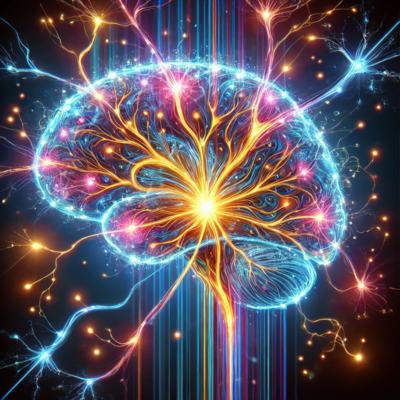Massage for Chronic Pain – The Biopsychosocial Model
How can I use massage for chronic pain? All pain begins in the central nervous system because the brain creates pain. The more the brain interprets nerve signals as pain, the better it gets at interpreting more signals as pain. Massage is an excellent way to interrupt this negative feedback loop. We accomplish this by providing it with positive stimuli in the form of pleasure. The goal is to convince the brain it doesn’t need to create pain in the first place. In pain management massage, we use the biopsychosocial model of pain and Lorimer Moseley’s pain theory to transform how your brain interprets pain.
The brain creates pain to protect us. Since most pain is a preventative method to avoid injury, the brain causes us to hurt because it loves us. In many respects, persistent and chronic pain is a helicopter parent trying to prevent us from injuring ourselves.

To solve this problem, we need to prove to our overprotective parent that we are responsible and safe. This is essential if we want avoid hurting every day.
The pain system is a tricky little creature, but it is there to protect us because it loves us. It wants us to thrive and live our best lives, but just like a parent, it can become overbearing. We can lessen our pain system’s tendency to be over protective by encouraging it to trust us, by using massage for chronic pain.
Building trust with the pain system
How do we convince our pain system to trust us? We need to offer it positive stimulation.
Earning the trust of your central nervous and pain systems requires more than an occasional massage. It is a comprehensive retooling of how you live and interact with life. At the core of pain management are three key components: hope, joy, and faith.
- Hope is more than wanting to survive; it is making the most of your moments and spending time with the special people in your life.
- Joy is being thankful for what you have, even when you no longer have it.
- Faith is trusting in something you cannot prove. Faith is a guiding light in the darkness when you cannot see. It is an ever-present reminder that no matter how challenging life may become, everything is going to be okay.
Filter everything in life through a lens of love. Avoid being envious, boastful, arrogant, or rude. Let go of your resentfulness, vendettas, and bitterness. Take some time to empathize, to assume others are just as clueless as you. We all make mistakes, so be prepared to offer forgiveness and give goodness for the sake of giving goodness.
When we filter our existence through clear, bright, and bold eyes, life becomes brilliant, encouraging us to feel alive. Focusing on the majestic aspects of existence shields our sight from life’s little annoyances. While this may seem silly at first, it will yield tremendous results.
Negativity begets negativity. If we want our central nervous system to trust us, we must show that we are safe and surrounded by abundance and health. We must feed it good things so it feels full and happy.
All change begins within. If we want to live the life we have always wanted to live, we must transform how we see life so we enjoy it once we are living it. When our central nervous system feels safe, its overprotectiveness will ease. Imagine how wonderful it would feel to be pain-free.
Holistic Pain Relief: Using the Biopsychosocial Model in Massage
What is the biopsychosocial model of pain? It is the theory that our personal experience of pain is decided by biological, psychological, and social influences. It deviates from prior pain models in that it does not ascribe tissue damage as the predominant pain factor. As a result, it encourages physicians and their patients to observe the entire picture to assess the sources of the pain and discomfort.
Biopsychosocial is a big word; at a glance, it may seem complex. However, it becomes easier to understand when we break it down into its essential components.
Bio is short for biological. It represents the physical elements that may result in pain. These may be genetic factors, tissue damage, disease, immune dysfunction, and hormonal issues. Additionally, it includes lifestyle factors such as obesity, insomnia, substance abuse, and physical activity. Our age and sex are factors; a pregnant woman will experience unique pain and discomfort specific to pregnancy. The bio element of the biopsychosocial framework of pain comprehensively represents any biological abnormality, decay, or change.
Psych is short for psychological. It represents the cognitive and emotional elements that may result in pain. These may include a person’s mood, stress level, anxiety, despair, outrage, anger, and worry. Additionally, a person’s coping style, outlook on life, beliefs, attitudes, and expectations influence their levels of pain and discomfort. The psych element of the biopsychosocial model of pain comprehensively represents an individual’s mental and emotional well-being.
Social is short for sociocultural. It represents the social factors that may influence pain. These may include a person’s social expectations, financial circumstances, education level, language and cultural barriers, isolation, relationship difficulties such as separation or divorce, changes in social status, absence of spiritual or religious guidance or community, and social stigma. The social element of the biopsychosocial pain model comprehensively represents an individual’s actual or perceived position, responsibilities, influence, expectations, and benefits within their community.
Moving Beyond Muscle Knots: Applying the Biopsychosocial Model to Massage
“Physicians and patients usually harbor a concept of pain that involves a linkage between body damage and the pain reported by the patient. This is an inadequate concept that leads both physicians and their patients into unnecessary difficulties in the management of chronic pain.” Loeser JD. Concepts of Pain. New York: Raven Press; 1982. A vital question – understand pain.
The massage industry is obsessed with muscle knots. Therapists may feel around all day searching for what they think is the obvious, palpable source of a client’s pain. Then, they press, poke, and rub this area, causing pain and discomfort, even when the “knot” did not hurt in the first place. While palpable knots may exist, the physical presence of soft tissue that seems to feel different does not indicate tissue damage or something that needs to be massaged away.
When a massage therapist overfocuses on palpable knots, it encourages the client to feel more discomfort, which further contributes to the negative feedback loop of pain. As massage therapists, our primary goal should be to provide peace and ease to the central nervous system. The neat thing about targeting the CNS in massage is that we can help facilitate indirect neurological improvements by regularly providing positive stimuli for the brain to interpret. This is how we use massage for chronic pain.
Chronic Pain is Like an Overprotective Parent
Massaging a client’s muscles and soft tissues is our means of encouraging the autonomic nervous system to feel safe. As a result, it grants us the unique opportunity to provide positive stimuli that may help retrain the brain’s perception of touch and movement.
If we want a massage to have lasting benefits. The therapist must listen to their clientele and look beyond palpable knots. Due to palpatory pareidolia, knots can be identified even when they do not exist. This means a therapist can feel what they believe is a tissue abnormality or damage and then attempt to resolve it using unnecessary and potentially painful methods. Doing this is the opposite of what the central nervous system needs because using pain to reduce pain is like burning down a forest to prevent a forest fire.
Rather than searching for palpable knots, we need to listen to what the client describes as knots. While a massage therapist may know a lot about massage and the methods to reduce pain through bodywork, the client has existed in their body their entire life. A massage therapist must have the humility to admit that the client is the expert of their own body. This is why what they share with us is so important. It doesn’t matter if the knot they describe is palpable; what matters is that it hurts.
When we listen to the client describe how they hurt, we engage the psych element of the biopsychosocial model of pain. It feels good to be heard, to know our voice has value and meaning. If you have ever visited a doctor for an ailment, yet they sit with their back to you or seem to ignore most of what you have to say, it doesn’t feel good. As a result, we often leave their office feeling worse than when we arrived. Chiropractors are typically really good at giving their patients quality engagement and attention. I believe this is because, as holistic practitioners, they understand the importance of giving people a voice.
When massaging your clients, listen to them. If they point out a knot, ask them how it feels and collect as much information as you can about the sensation. Communicate with them as you work on the area, and ask them if the sensation of your touch or the affecting area has changed. Be prepared to adapt in the moment so the session remains focused on them. This experience feels good because they are your sole focus for the duration of the massage. In life, it is rare to get someone’s undivided attention. If the client’s emotional well-being is uplifted by the experience, this will influence their mood. As a result, it will help reduce their persistent and chronic pain. When you do this, you are encouraging a positive feedback loop.
